CCTV Technology: Impact on Society, Law, and Human Rights
VerifiedAdded on 2021/12/27
|5
|1310
|21
Report
AI Summary
This report examines the implementation and impact of Closed-Circuit Television (CCTV) technology, primarily within the private sector, as a means of addressing serious crimes and enhancing security. The report delves into the technology's role in crime prevention, citing examples of its use in investigating and solving cases. It explores the social, political, and legal ramifications of CCTV, including its impact on privacy, civil liberties, and human rights. The discussion encompasses debates surrounding accountability, data usage, and the balance between security and individual freedoms. The report concludes by highlighting the technology's effectiveness in reducing crime rates while acknowledging the critical need to address associated challenges related to privacy infringement and the protection of human rights. References include academic papers and online resources discussing the impact of CCTV.
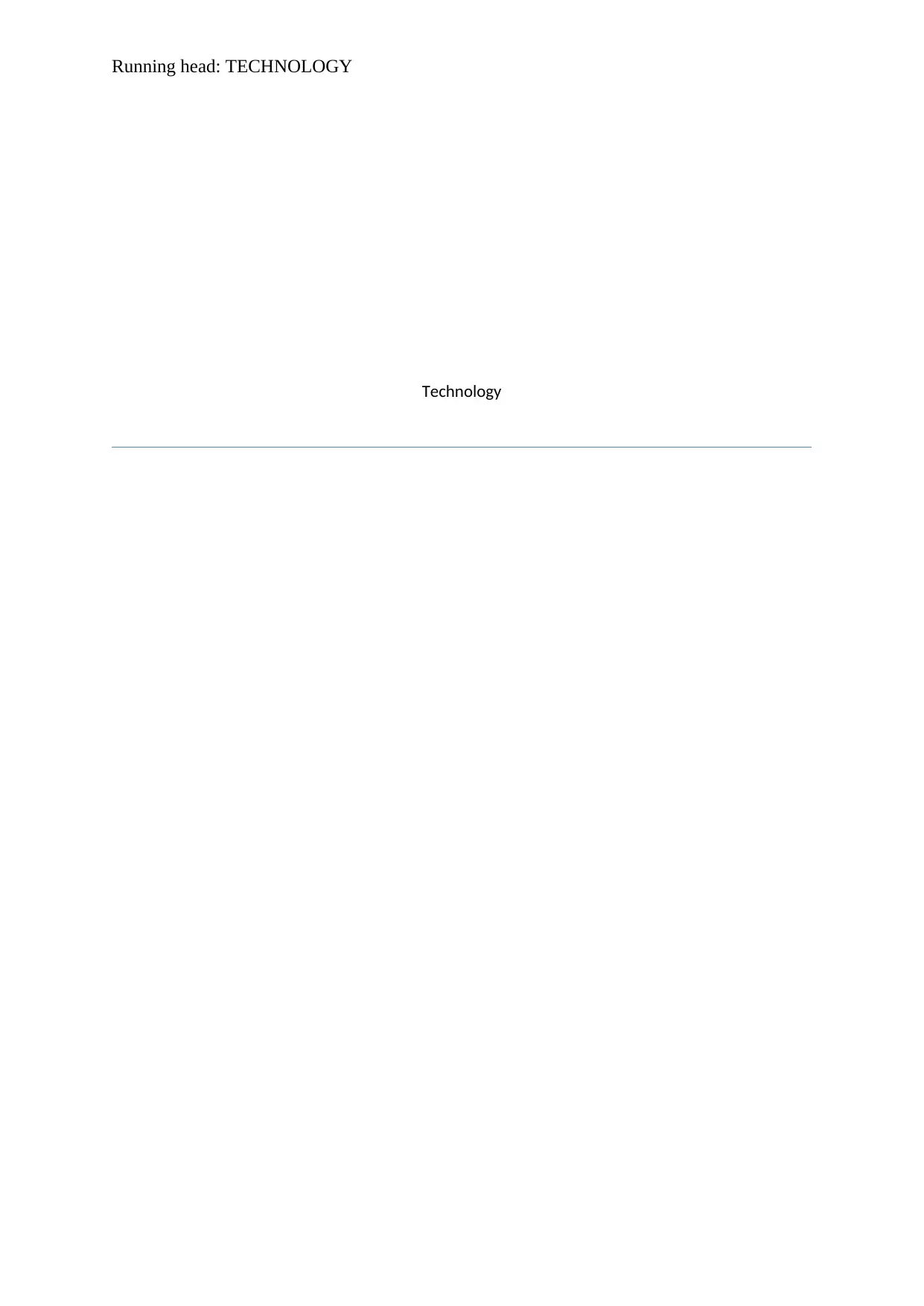
Running head: TECHNOLOGY
Technology
Technology
Paraphrase This Document
Need a fresh take? Get an instant paraphrase of this document with our AI Paraphraser
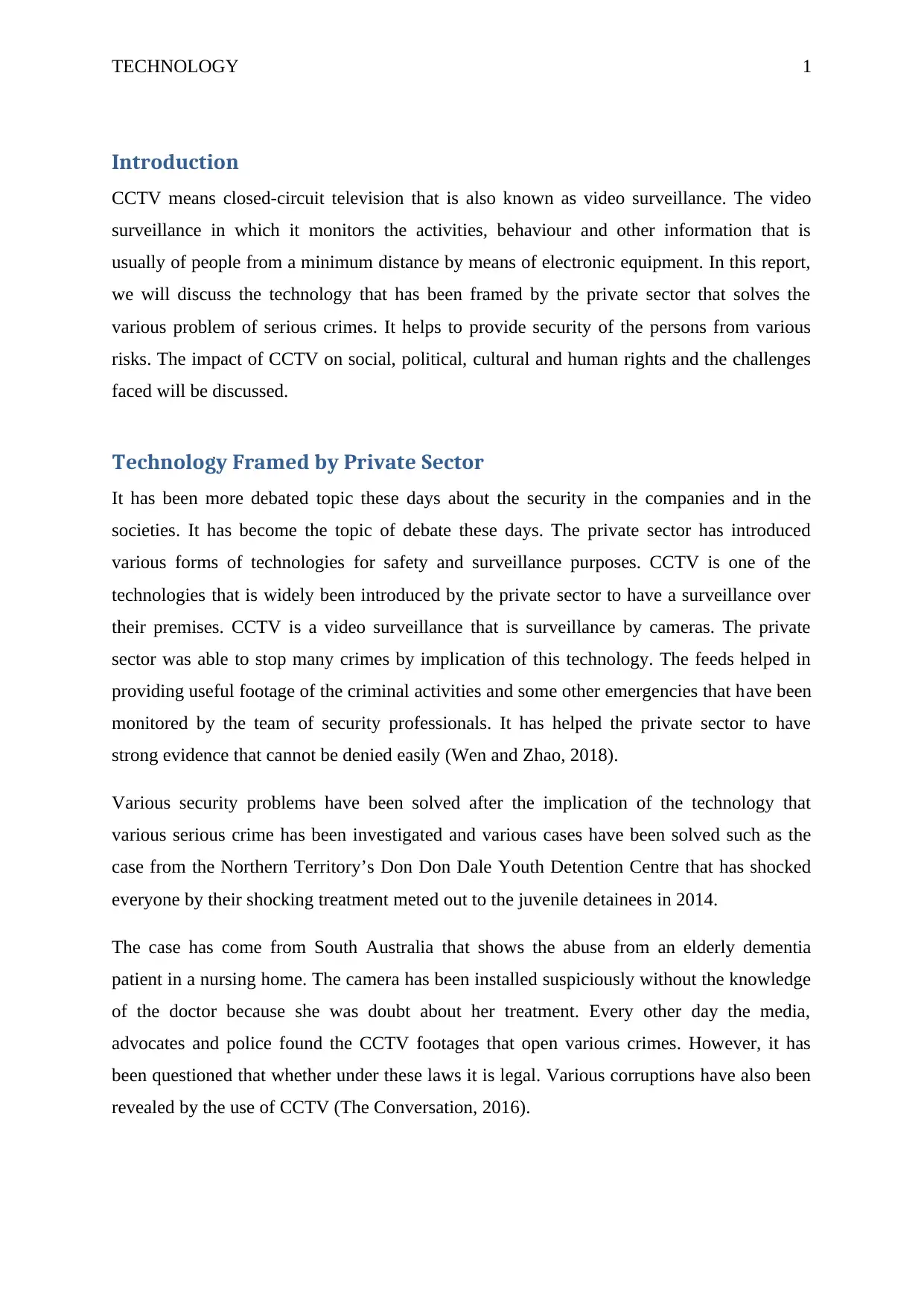
TECHNOLOGY 1
Introduction
CCTV means closed-circuit television that is also known as video surveillance. The video
surveillance in which it monitors the activities, behaviour and other information that is
usually of people from a minimum distance by means of electronic equipment. In this report,
we will discuss the technology that has been framed by the private sector that solves the
various problem of serious crimes. It helps to provide security of the persons from various
risks. The impact of CCTV on social, political, cultural and human rights and the challenges
faced will be discussed.
Technology Framed by Private Sector
It has been more debated topic these days about the security in the companies and in the
societies. It has become the topic of debate these days. The private sector has introduced
various forms of technologies for safety and surveillance purposes. CCTV is one of the
technologies that is widely been introduced by the private sector to have a surveillance over
their premises. CCTV is a video surveillance that is surveillance by cameras. The private
sector was able to stop many crimes by implication of this technology. The feeds helped in
providing useful footage of the criminal activities and some other emergencies that have been
monitored by the team of security professionals. It has helped the private sector to have
strong evidence that cannot be denied easily (Wen and Zhao, 2018).
Various security problems have been solved after the implication of the technology that
various serious crime has been investigated and various cases have been solved such as the
case from the Northern Territory’s Don Don Dale Youth Detention Centre that has shocked
everyone by their shocking treatment meted out to the juvenile detainees in 2014.
The case has come from South Australia that shows the abuse from an elderly dementia
patient in a nursing home. The camera has been installed suspiciously without the knowledge
of the doctor because she was doubt about her treatment. Every other day the media,
advocates and police found the CCTV footages that open various crimes. However, it has
been questioned that whether under these laws it is legal. Various corruptions have also been
revealed by the use of CCTV (The Conversation, 2016).
Introduction
CCTV means closed-circuit television that is also known as video surveillance. The video
surveillance in which it monitors the activities, behaviour and other information that is
usually of people from a minimum distance by means of electronic equipment. In this report,
we will discuss the technology that has been framed by the private sector that solves the
various problem of serious crimes. It helps to provide security of the persons from various
risks. The impact of CCTV on social, political, cultural and human rights and the challenges
faced will be discussed.
Technology Framed by Private Sector
It has been more debated topic these days about the security in the companies and in the
societies. It has become the topic of debate these days. The private sector has introduced
various forms of technologies for safety and surveillance purposes. CCTV is one of the
technologies that is widely been introduced by the private sector to have a surveillance over
their premises. CCTV is a video surveillance that is surveillance by cameras. The private
sector was able to stop many crimes by implication of this technology. The feeds helped in
providing useful footage of the criminal activities and some other emergencies that have been
monitored by the team of security professionals. It has helped the private sector to have
strong evidence that cannot be denied easily (Wen and Zhao, 2018).
Various security problems have been solved after the implication of the technology that
various serious crime has been investigated and various cases have been solved such as the
case from the Northern Territory’s Don Don Dale Youth Detention Centre that has shocked
everyone by their shocking treatment meted out to the juvenile detainees in 2014.
The case has come from South Australia that shows the abuse from an elderly dementia
patient in a nursing home. The camera has been installed suspiciously without the knowledge
of the doctor because she was doubt about her treatment. Every other day the media,
advocates and police found the CCTV footages that open various crimes. However, it has
been questioned that whether under these laws it is legal. Various corruptions have also been
revealed by the use of CCTV (The Conversation, 2016).
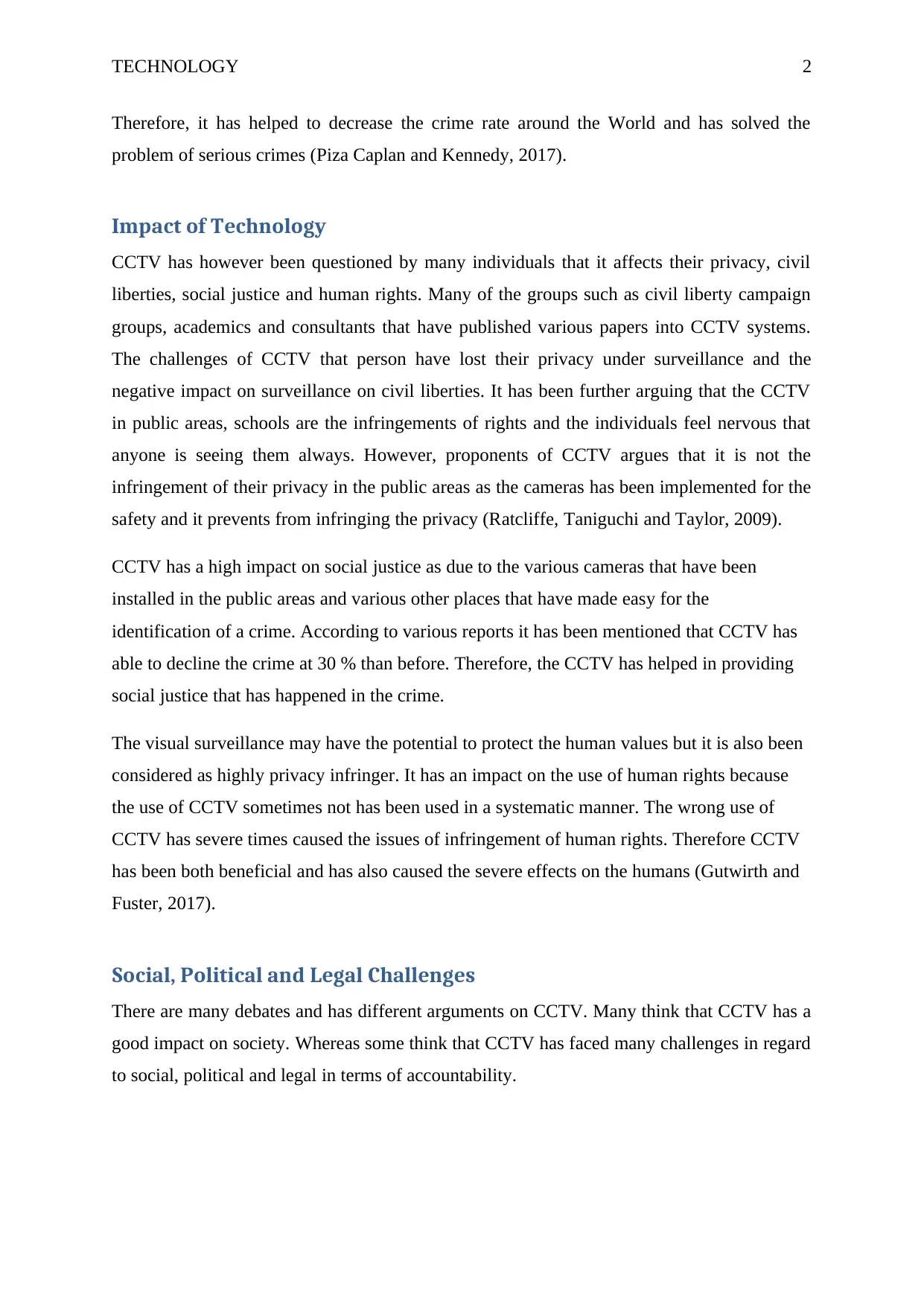
TECHNOLOGY 2
Therefore, it has helped to decrease the crime rate around the World and has solved the
problem of serious crimes (Piza Caplan and Kennedy, 2017).
Impact of Technology
CCTV has however been questioned by many individuals that it affects their privacy, civil
liberties, social justice and human rights. Many of the groups such as civil liberty campaign
groups, academics and consultants that have published various papers into CCTV systems.
The challenges of CCTV that person have lost their privacy under surveillance and the
negative impact on surveillance on civil liberties. It has been further arguing that the CCTV
in public areas, schools are the infringements of rights and the individuals feel nervous that
anyone is seeing them always. However, proponents of CCTV argues that it is not the
infringement of their privacy in the public areas as the cameras has been implemented for the
safety and it prevents from infringing the privacy (Ratcliffe, Taniguchi and Taylor, 2009).
CCTV has a high impact on social justice as due to the various cameras that have been
installed in the public areas and various other places that have made easy for the
identification of a crime. According to various reports it has been mentioned that CCTV has
able to decline the crime at 30 % than before. Therefore, the CCTV has helped in providing
social justice that has happened in the crime.
The visual surveillance may have the potential to protect the human values but it is also been
considered as highly privacy infringer. It has an impact on the use of human rights because
the use of CCTV sometimes not has been used in a systematic manner. The wrong use of
CCTV has severe times caused the issues of infringement of human rights. Therefore CCTV
has been both beneficial and has also caused the severe effects on the humans (Gutwirth and
Fuster, 2017).
Social, Political and Legal Challenges
There are many debates and has different arguments on CCTV. Many think that CCTV has a
good impact on society. Whereas some think that CCTV has faced many challenges in regard
to social, political and legal in terms of accountability.
Therefore, it has helped to decrease the crime rate around the World and has solved the
problem of serious crimes (Piza Caplan and Kennedy, 2017).
Impact of Technology
CCTV has however been questioned by many individuals that it affects their privacy, civil
liberties, social justice and human rights. Many of the groups such as civil liberty campaign
groups, academics and consultants that have published various papers into CCTV systems.
The challenges of CCTV that person have lost their privacy under surveillance and the
negative impact on surveillance on civil liberties. It has been further arguing that the CCTV
in public areas, schools are the infringements of rights and the individuals feel nervous that
anyone is seeing them always. However, proponents of CCTV argues that it is not the
infringement of their privacy in the public areas as the cameras has been implemented for the
safety and it prevents from infringing the privacy (Ratcliffe, Taniguchi and Taylor, 2009).
CCTV has a high impact on social justice as due to the various cameras that have been
installed in the public areas and various other places that have made easy for the
identification of a crime. According to various reports it has been mentioned that CCTV has
able to decline the crime at 30 % than before. Therefore, the CCTV has helped in providing
social justice that has happened in the crime.
The visual surveillance may have the potential to protect the human values but it is also been
considered as highly privacy infringer. It has an impact on the use of human rights because
the use of CCTV sometimes not has been used in a systematic manner. The wrong use of
CCTV has severe times caused the issues of infringement of human rights. Therefore CCTV
has been both beneficial and has also caused the severe effects on the humans (Gutwirth and
Fuster, 2017).
Social, Political and Legal Challenges
There are many debates and has different arguments on CCTV. Many think that CCTV has a
good impact on society. Whereas some think that CCTV has faced many challenges in regard
to social, political and legal in terms of accountability.
⊘ This is a preview!⊘
Do you want full access?
Subscribe today to unlock all pages.

Trusted by 1+ million students worldwide
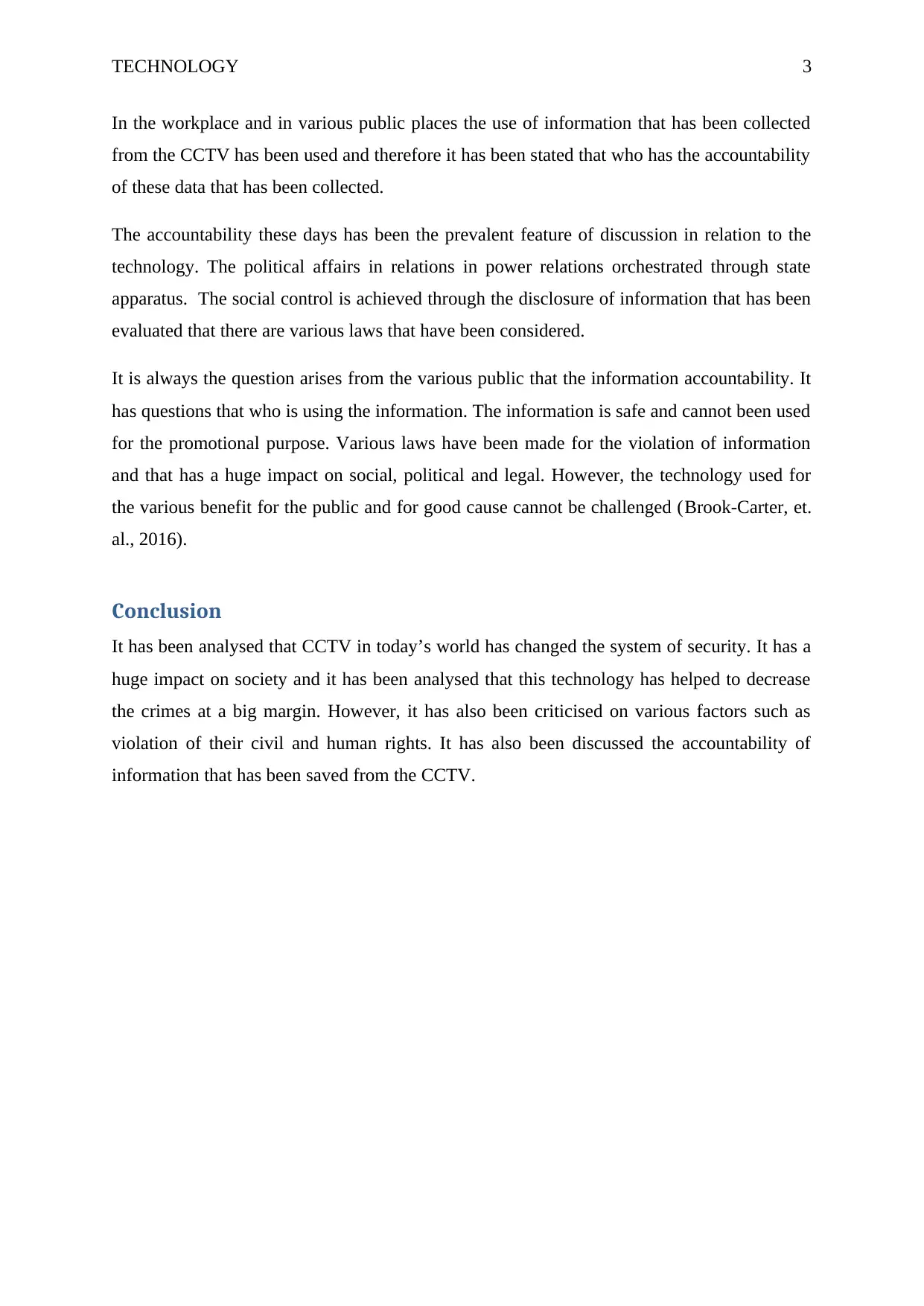
TECHNOLOGY 3
In the workplace and in various public places the use of information that has been collected
from the CCTV has been used and therefore it has been stated that who has the accountability
of these data that has been collected.
The accountability these days has been the prevalent feature of discussion in relation to the
technology. The political affairs in relations in power relations orchestrated through state
apparatus. The social control is achieved through the disclosure of information that has been
evaluated that there are various laws that have been considered.
It is always the question arises from the various public that the information accountability. It
has questions that who is using the information. The information is safe and cannot been used
for the promotional purpose. Various laws have been made for the violation of information
and that has a huge impact on social, political and legal. However, the technology used for
the various benefit for the public and for good cause cannot be challenged (Brook-Carter, et.
al., 2016).
Conclusion
It has been analysed that CCTV in today’s world has changed the system of security. It has a
huge impact on society and it has been analysed that this technology has helped to decrease
the crimes at a big margin. However, it has also been criticised on various factors such as
violation of their civil and human rights. It has also been discussed the accountability of
information that has been saved from the CCTV.
In the workplace and in various public places the use of information that has been collected
from the CCTV has been used and therefore it has been stated that who has the accountability
of these data that has been collected.
The accountability these days has been the prevalent feature of discussion in relation to the
technology. The political affairs in relations in power relations orchestrated through state
apparatus. The social control is achieved through the disclosure of information that has been
evaluated that there are various laws that have been considered.
It is always the question arises from the various public that the information accountability. It
has questions that who is using the information. The information is safe and cannot been used
for the promotional purpose. Various laws have been made for the violation of information
and that has a huge impact on social, political and legal. However, the technology used for
the various benefit for the public and for good cause cannot be challenged (Brook-Carter, et.
al., 2016).
Conclusion
It has been analysed that CCTV in today’s world has changed the system of security. It has a
huge impact on society and it has been analysed that this technology has helped to decrease
the crimes at a big margin. However, it has also been criticised on various factors such as
violation of their civil and human rights. It has also been discussed the accountability of
information that has been saved from the CCTV.
Paraphrase This Document
Need a fresh take? Get an instant paraphrase of this document with our AI Paraphraser
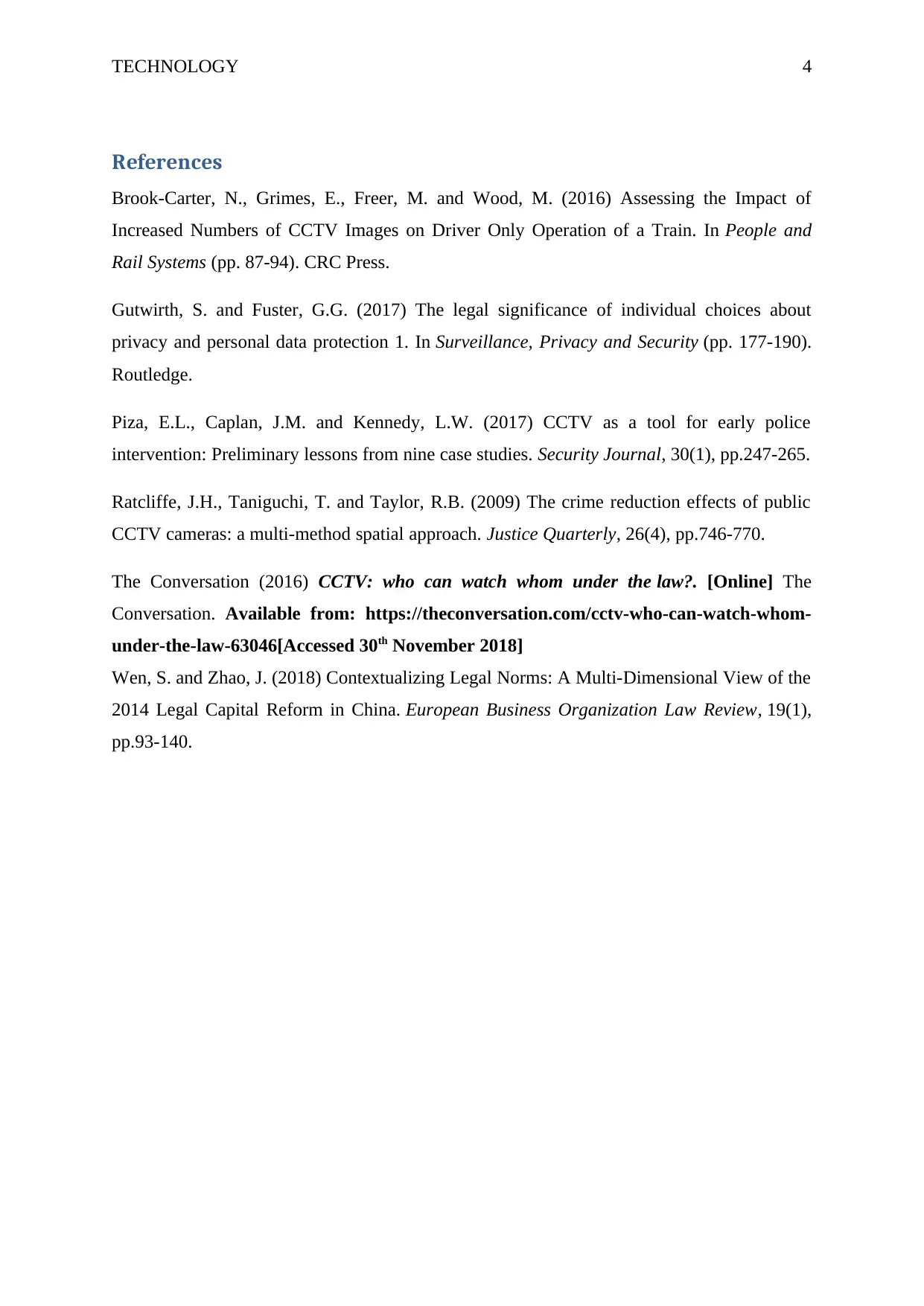
TECHNOLOGY 4
References
Brook-Carter, N., Grimes, E., Freer, M. and Wood, M. (2016) Assessing the Impact of
Increased Numbers of CCTV Images on Driver Only Operation of a Train. In People and
Rail Systems (pp. 87-94). CRC Press.
Gutwirth, S. and Fuster, G.G. (2017) The legal significance of individual choices about
privacy and personal data protection 1. In Surveillance, Privacy and Security (pp. 177-190).
Routledge.
Piza, E.L., Caplan, J.M. and Kennedy, L.W. (2017) CCTV as a tool for early police
intervention: Preliminary lessons from nine case studies. Security Journal, 30(1), pp.247-265.
Ratcliffe, J.H., Taniguchi, T. and Taylor, R.B. (2009) The crime reduction effects of public
CCTV cameras: a multi‐method spatial approach. Justice Quarterly, 26(4), pp.746-770.
The Conversation (2016) CCTV: who can watch whom under the law?. [Online] The
Conversation. Available from: https://theconversation.com/cctv-who-can-watch-whom-
under-the-law-63046[Accessed 30th November 2018]
Wen, S. and Zhao, J. (2018) Contextualizing Legal Norms: A Multi-Dimensional View of the
2014 Legal Capital Reform in China. European Business Organization Law Review, 19(1),
pp.93-140.
References
Brook-Carter, N., Grimes, E., Freer, M. and Wood, M. (2016) Assessing the Impact of
Increased Numbers of CCTV Images on Driver Only Operation of a Train. In People and
Rail Systems (pp. 87-94). CRC Press.
Gutwirth, S. and Fuster, G.G. (2017) The legal significance of individual choices about
privacy and personal data protection 1. In Surveillance, Privacy and Security (pp. 177-190).
Routledge.
Piza, E.L., Caplan, J.M. and Kennedy, L.W. (2017) CCTV as a tool for early police
intervention: Preliminary lessons from nine case studies. Security Journal, 30(1), pp.247-265.
Ratcliffe, J.H., Taniguchi, T. and Taylor, R.B. (2009) The crime reduction effects of public
CCTV cameras: a multi‐method spatial approach. Justice Quarterly, 26(4), pp.746-770.
The Conversation (2016) CCTV: who can watch whom under the law?. [Online] The
Conversation. Available from: https://theconversation.com/cctv-who-can-watch-whom-
under-the-law-63046[Accessed 30th November 2018]
Wen, S. and Zhao, J. (2018) Contextualizing Legal Norms: A Multi-Dimensional View of the
2014 Legal Capital Reform in China. European Business Organization Law Review, 19(1),
pp.93-140.
1 out of 5
Related Documents
Your All-in-One AI-Powered Toolkit for Academic Success.
+13062052269
info@desklib.com
Available 24*7 on WhatsApp / Email
![[object Object]](/_next/static/media/star-bottom.7253800d.svg)
Unlock your academic potential
Copyright © 2020–2025 A2Z Services. All Rights Reserved. Developed and managed by ZUCOL.





